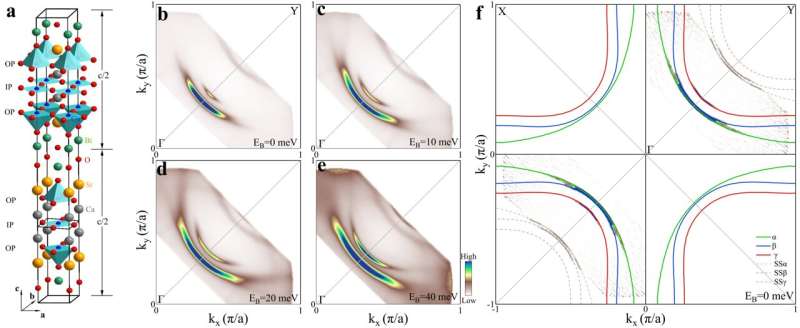November 1, 2023 feature
This article has been reviewed according to Science X's editorial process and policies. Editors have highlighted the following attributes while ensuring the content's credibility:
fact-checked
peer-reviewed publication
trusted source
proofread
Study reveals the origin of high superconducting critical temperatures in trilayer cuprates

High-temperature cuprate superconductors are a broad class of materials that exhibit some unique characteristics. Due to their distinctive properties, these materials exhibit the highest superconducting temperatures reported to date under ambient pressure.
Researchers at the Chinese Academy of Sciences and other institutes in China recently carried out a study aimed at better understanding the processes underpinning the high superconducting critical temperatures (Tc) observed in trilayer cuprates, a class of materials with three layers based on compounds containing copper. Their paper, published in Nature Physics, unveiled the electronic origin of the high Tc exhibited by these three-layered materials.
"Our group has been trying to understand the high temperature superconductivity mechanism in cuprate superconductors for many years," Xingjiang Zhou, one of the researchers who carried out the study, told Phys.org.
"Previous works found that the critical temperature (Tc) of cuprate superconductors depends sensitively on the number of CuO2 planes (n) in one structural unit and it is maximized for three-layer (n=3) cuprates. Some also found that the three-layer cuprates show electronic phase diagram that is different from the usual phase diagram."
Past studies showed that the Tc remains almost constant in the overdoped region of trilayer cuprates, while in other cuprates (i.e., copper-based materials with fewer layers), the Tc goes down as the doping of this region increases. The key objective of the recent work by Zhou and his colleagues was to pin-point the origin of this Tc maximization and its persistence in the overdoped region of three-layered cuprates.
"We carried out high resolution angle-resolved photoemission (ARPES) measurements on the three-layer cuprate superconductor Bi2223," Zhou explained. "ARPES is a powerful experimental technique which can directly measure the energy band, Fermi surface and superconducting gap of a superconductor. Bi2223 is a typical three-layer cuprate superconductor which can be easily cleaved to get smooth surface which is important for ARPES measurements."
In their experiments, Zhou and his colleagues observed the trilayer splitting of the Fermi surface (i.e., three Fermi surface sheets) in the trilayer cuprate Bi2223 for the very first time. Subsequently, the team measured the materials' band structures, which led to the observation of a physical phenomenon known as Bogoliubov band hybridization.
"We determined the superconducting gap on all the three Fermi surface sheets," Zhou said. "Collectively, these experimental results make it possible to reveal the microscopic process in the electron hopping and pairing in Bi2223. They particularly allow us to understand why Tc is high for the three-layer cuprates and why Tc does not change in the overdoped region in Bi2223."
Notably, the findings gathered as part of this recent work are consistent with the so-called composite picture, a theory introduced twenty years ago aimed at making Tc even higher. Therefore, they highlight the value of the composite picture for guiding the future design and search for new superconductors with increasingly high superconducting critical temperatures.
"We showed that Bi2223 is an ideal system to study high temperature superconductivity mechanisms and related physics," Zhou added. "The inner CuO2 layer is well protected from disorders which facilitates to study the intrinsic electronic structure. We will continue to work on this system by studying the doping evolution of its electronic structure and superconducting gap."
More information: Xiangyu Luo et al, Electronic origin of high superconducting critical temperature in trilayer cuprates, Nature Physics (2023). DOI: 10.1038/s41567-023-02206-0.
Journal information: Nature Physics
© 2023 Science X Network





















